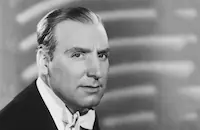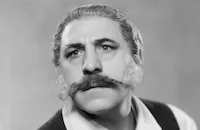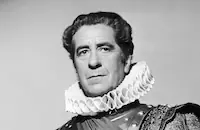Night Life of the Gods
Brief Synopsis
Cast & Crew
Lowell Sherman
Alan Mowbray
Florine Mckinney
Peggy Shannon
Richard Carle
Theresa Maxwell Conover
Film Details
Technical Specs

Synopsis
Scientist Hunter Hawk sets off a series of explosions in his laboratory and is knocked unconscious. When he comes to, he discovers his experiment has been successful. With the use of a magic ring that emits a supernatural ray, Hunter can turn people into stone and, with a second ring, back to life, and can turn statues into flesh and blood. Hunter first tries his ray on his greedy, annoying relatives, turning all but his niece Daphne into stone. That night, Daphne and her boyfriend, Cyril Sparks, go dancing with Hunter and his gardener Turner's daughter Meg, who claims she is nine hundred years old. Hunter and Meg fall in love and sit up together through the night. The next day, they go New York's Metropolitan Museum of Art and bring to life eight statues of gods and goddesses: Mercury, Bacchus, Neptune, Apollo, Perseus, Hebe, Diana and the Venus de Milo, without her arms. After buying them clothes and checking them into the Waldorf-Astoria Hotel, Meg and Hunter show the deities civilization. Eventually, however, the gods realize they cannot fit into modern life. Bacchus cannot stomach modern alcohol; Venus is unable to find a lover; and Neptune cannot tolerate having to pay for fish. Meanwhile, policeman Mike Mulligan, whom Hunter had turned to stone but who was able to free himself from the spell, is after Hunter for wreaking havoc around town. Hunter gets the gods back to the museum, where they all agree to return to stone, but strike different poses. Hunter then tells Meg that, for her own safety, it would be better if she left him. She vows to stay with him, however, and they turn themselves into stone for eternity. Hunter then wakes up in an ambulance and realizes it was all a dream.

Director

Lowell Sherman
Cast

Alan Mowbray
Florine Mckinney

Peggy Shannon

Richard Carle
Theresa Maxwell Conover

Phillips Smalley

Wesley Barry

Gilbert Emery
Ferdinand Gottschalk

Douglas Fowley

William Boyd (stage)

Henry Armetta
Alene Carroll
Raymond Benard
George Hassell
Irene Ware
Geneva Mitchell
Paul Kaye

Robert Warwick
Pat De Cicco
Marda Deering
May Beatty
Alan Davis
Leo Mccabe
Bert Roach
Maidel Turner
Fredric Santly
Maude Turner Gordon
Ruth Cherrington
Tyler Brooke
Lee Moran
G. Pat Collins
Wade Boteler

Don Douglas
Harry Cornell
Joseph Young
Dick Winslow
Harold Nelson
Beatrice Roberts
Claire Meyers
Madlyn Talcot
William L. Thorne
Velma Gresham
Al Hill
Anne Darling
Russ Clark
Larry Wheat
Jean Warwick

Ann Doran
Lu Ann Meredith
Ruth Page
Lois January

Charles Irwin
Phyllis Crane
Lillian Castle
James Burtis
Crew
Pete Abriss
Frank Carr
William Dodds
Grace Dubray
John P. Fulton
Charles Gould
King Gray
Harry Grundstrum
Bernie Guffey
Archie Hall
Charles D. Hall
William Hedgcock
Gertrude Helmer
Ross Hoffman
Tony Holtz
Ted Kent
Jas. C. Knowlton
Gilbert Kurland
Carl Laemmle Jr.
Carl Laemmle
Carl Laemmle
Otto Lederer
Frank Madigan
Harold Mccarl
Doris Mccoig
Pat Mccoy
Joseph A. Mcdonough
John J. Mescall
Harry Moran
Arthur Morton
M. F. Murphy
Maurice Pivar
Ross Saxon
Edna Simons
Fred Starns
Barry Trivers
Edward Ward
Ed Ware
S. B. Ware

Film Details
Technical Specs

Quotes
Trivia
Notes
Although not viewed, the credits for this film were taken from a studio cutting continuity. The title reads: "Thorne Smith's Night Life of the Gods." The foreword reads: "Once upon a time, a famous author named Thorne Smith wrote a book, conceived in a moment of delicious delirium, and written in a cuckoo clock. The first chapters convinced us he was crazy. The ensuing left doubt that possibly we were. So we leave you to enjoy this new and completely mad type of whimsical humor on the screen. Stop rattling cellophane! Take Sonny's shoes off! Park your gum under the seat where it belongs, and let's all go crazy together."
According to a news item in Daily Variety on August 8, 1934, Universal hired five sculptors to make life-size plastic figures for the film, many of which would resemble the cast members. Daily Variety also reported that as many as thirty sculptors might be needed to finish the statues in time for production. The New York Times reviewer remarked that "the current cinema morality has forced [director] Sherman to abandon most of the ribald humor of the original." All of the film's reviews except Variety and New York Times state that the film ends with Hunter turning himself and Meg into stone. Variety describes the dream ending (included in the above plot), which was part of the continuity script. Due to the fact that Variety reviewed the film last, the dream ending May have been added after the film was previewed. The New York Times review does not refer to the ending at all. Night Life of the Gods was the last complete film that Sherman acted in or directed. He died in late December 1934 while directing Becky Sharp.












